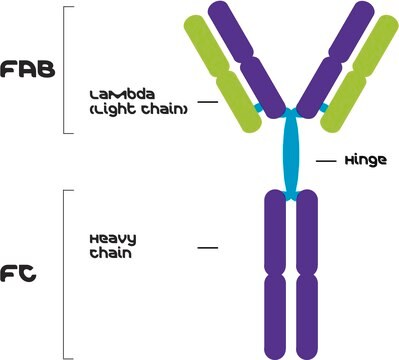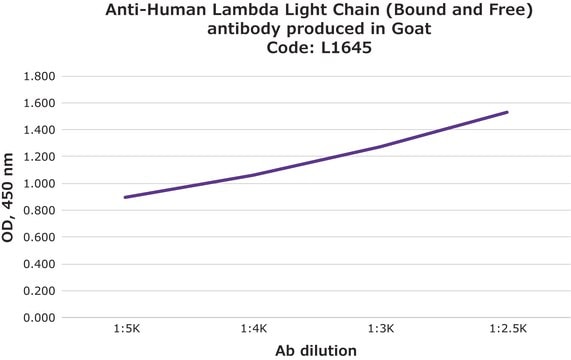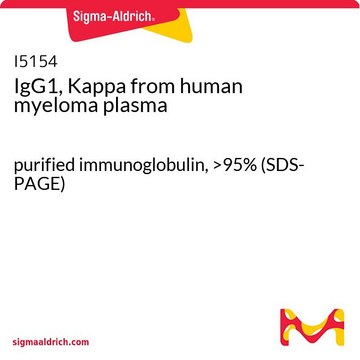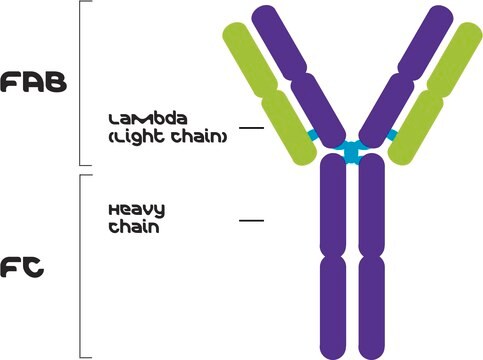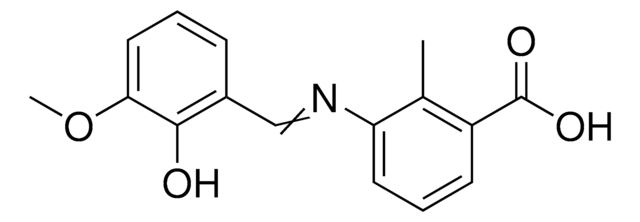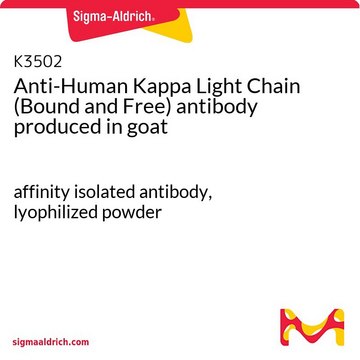Alle Fotos(1)
Wichtige Dokumente
I3784
IgG3, Kappa from murine myeloma
clone DX, purified immunoglobulin, buffered aqueous solution
Synonym(e):
Mouse IgG3-κ
Anmeldenzur Ansicht organisationsspezifischer und vertraglich vereinbarter Preise
Alle Fotos(1)
About This Item
Empfohlene Produkte
Biologische Quelle
mouse
Qualitätsniveau
Konjugat
unconjugated
Antikörperform
purified immunoglobulin
Klon
DX, monoclonal
Assay
≥95% (microfluidic capillary gel electrophoresis)
Form
buffered aqueous solution
Versandbedingung
dry ice
Lagertemp.
−20°C
Suchen Sie nach ähnlichen Produkten? Aufrufen Leitfaden zum Produktvergleich
Allgemeine Beschreibung
IgG antibody subtype is the most abundant serum immunoglobulins of the immune system. It is secreted by B cells and is found in blood and extracellular fluids and provides protection from infections caused by bacteria, fungi and viruses. Maternal IgG is transferred to fetus through the placenta that is vital for immune defence of the neonate against infections. IgG3 is the has a unique extended hinge region conferring greater flexibility
IgG3, κ from murine myeloma specifically recognizes mouse IgG3. Specificity of the mouse IgG3, κ is determined by immunodiffusion and IEP techniques. The purified myeloma preparation is non-reactive with antisera to mouse IgA, IgM, IgD, IgG1, IgG2a and IgG2b.
IgG3, κ from murine myeloma specifically recognizes mouse IgG3. Specificity of the mouse IgG3, κ is determined by immunodiffusion and IEP techniques. The purified myeloma preparation is non-reactive with antisera to mouse IgA, IgM, IgD, IgG1, IgG2a and IgG2b.
Anwendung
IgG3, κ from murine myeloma was used as blocking agent in immunofluorescence labeling of larval and adult Echinococcus multilocularis worms. It was used as negative control in assay to study the surface binding of antibodies to meningococci.
Physikalische Form
Solution in Tris buffered saline, pH 7.2, containing 0.1% sodium azide.
Haftungsausschluss
Unless otherwise stated in our catalog or other company documentation accompanying the product(s), our products are intended for research use only and are not to be used for any other purpose, which includes but is not limited to, unauthorized commercial uses, in vitro diagnostic uses, ex vivo or in vivo therapeutic uses or any type of consumption or application to humans or animals.
Signalwort
Warning
H-Sätze
P-Sätze
Gefahreneinstufungen
Eye Irrit. 2 - Skin Irrit. 2
Lagerklassenschlüssel
10 - Combustible liquids
WGK
WGK 2
Flammpunkt (°F)
Not applicable
Flammpunkt (°C)
Not applicable
Hier finden Sie alle aktuellen Versionen:
Besitzen Sie dieses Produkt bereits?
In der Dokumentenbibliothek finden Sie die Dokumentation zu den Produkten, die Sie kürzlich erworben haben.
Chi-An Hsu et al.
Proteomics, 8(10), 2115-2125 (2008-05-21)
Many potential vaccine candidates for serogroup B Neisseria meningitidis (NMB) have been identified by reverse vaccinology, a genome-based approach. However, some candidates may be unseen owing to uncertain annotation or their peculiar properties. In this study, we describe the preparation
Andreas J Hülsmeier et al.
Glycobiology, 20(1), 127-135 (2009-10-14)
A major surface constituent of Echinococcus multilocularis adult worms, referred to as an EmA9 antigen, was immunoaffinity purified and identified as a high-molecular-weight glycoconjugate. Labeling studies using the monoclonal antibody MAbEmA9 indicated that this antigen undergoes a regulated expression during
Philip Roelandt et al.
Nature protocols, 5(7), 1324-1336 (2010-07-03)
Differentiation of stem cells to hepatocytes has industrial applications, as well as the potential to develop new therapeutic strategies for liver disease. The protocol described here, sequentially using cytokines that are known to have a role in liver embryonic development
Masayuki Hirano et al.
Nature immunology, 8(7), 762-771 (2007-06-15)
Because functional analysis of Fc receptors (FcRs) relies heavily on mouse models, the identification of another Fcgamma receptor is particularly noteworthy. We demonstrate that FcgammaRIV, identified here as the mouse ortholog of primate FcgammaRIII, required association of the FcR gamma-chain
S Hashira et al.
Pediatrics international : official journal of the Japan Pediatric Society, 42(4), 337-342 (2000-09-15)
Maternal immunoglobulin G (IgG), transferred across the placenta to the fetus during intrauterine life, is an important component of the neonatal immunological defence mechanisms against infection. There is controversy with respect to differences in placental transfer of the different IgG
Unser Team von Wissenschaftlern verfügt über Erfahrung in allen Forschungsbereichen einschließlich Life Science, Materialwissenschaften, chemischer Synthese, Chromatographie, Analytik und vielen mehr..
Setzen Sie sich mit dem technischen Dienst in Verbindung.